the worst shoes for your feet
AUTHOR: Marc Mitnick DPM
home --> the worst shoes for your feet
Throughout this site I have mentioned again and again how certain types of shoes can cause and aggravate various foot and ankle problems. Pretty much on a weekly basis I have patients present to the office with various foot problems that I ultimately blame on the shoes that they are wearing.
If you develop a foot pain of some sort and have no explanation for how it began, always look to your shoes first. If a specific pain started a couple of days after wearing a new pair of shoes, look to them as the source of the problem. This is particularly true if you are having a similar pain in the same spot on both feet; the first place to look is at your shoes.
With that said, lets look at some of the culprits.
worn out shoes
Shoes are built to serve a function besides keeping us from stepping on broken glass and nails. Their primary goal is to support your feet in a particular manner so that you can walk in a proper gait.
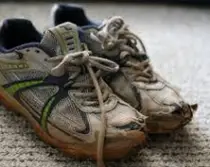
|
Yes, some shoes are designed particularly for style and less for support but even those shoes have certain properties which help propel us.
In general once a shoe begins to "fall apart" it starts to work against your ability to walk properly. This concept is of greater significance in athletic shoes and other shoes which attempt to help certain foot types.
As I said earlier when you develop a foot pain of some sort, looking at your shoes is the first place to start. This is especially true in athletic shoes. Athletic shoes have characteristics which help an athlete perform better, so once an athletic shoe starts to fail in its original purpose, pain and injury will ensue.
Serious athletes are always advised to replace their athletic shoes at certain intervals even if they may appear to be in good shape at the time. I have seen many runners over the years who will mention that they change their shoes at certain time intervals based on the amount of mileage that they have put on them, this way they avoid the surprise of having pain because their running shoes have worn out and are no longer supporting in the designed way.
flip flops and very thin sandals
Every summer I know I am going to see in influx of plantar fasciitis and capsulitis as a result of people wearing flip flops and those that wear very flimsy sandals. Aside from the fact that these types of shoes barely protect your feet, their structure is such that opens you up to certain types of foot pain.
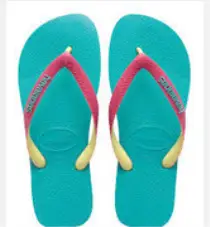
|
These are shoes that were originally designed for the pool or beach, to be worn on a limited basis, solely to protect the bottom of the feet. As time has passed, flip flops and sandals have become an every day shoe for many people and that is where the problem begins.
These shoes offer absolutely no support through the arch and heel. Yes, there are some sandals and flip flops out there that have an arch support component to them, but I am talking about shoes such as the ones pictured here. Because they do not support the arch, those who are prone to developing plantar fasciitis have the problem exacerbated by wearing these types of shoes.
These types of shoes not only fail to support the arch, but because they are so flexible, they can cause the toes to over stretch and thus put a lot of pressure on the ball of the feet resulting in capsulitis and metatarsalgia as well as sesamoiditis .
The problem with flip flops and thin soled sandals is exacerbated when people are in situations where all of a sudden they have to run in them. Because these shoes are not held firmly in place on the feet, people either fall or at the very least end up scuffing their feet causing anywhere from minor to moderate trauma to their feet.
stiletto heels
Just by looking at a pair of high heel shoes any one can see the potential for foot problems after wearing them. Sure they look great, but worn on an every day basis will lead to problems of one kind or another in most women.
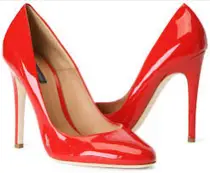
|
Years ago when I first started in practice, when a women came in with a problem and I noticed that she was wearing stiletto heels, the first thing I did was give her a lecture on why her shoes were causing her pain and then discussed the proper type of shoe that she should be wearing. What a fool was I! These patients would very politely "yes" me to death and then go out and buy the types of shoes that looked good (stiletto heels), rather than the types of shoes that were good for their feet. So, stiletto heels are here to stay.
With that said, these types of shoes will also cause a multiple array of foot problems over time. Unique to these shoes is Achilles tendonitis. For women who wear this type of shoe on a daily basis, over time the Achilles tendon will begin to shorten. This is the nature of tendons; they adapt to the least amount of stress placed on them.
After years of wearing heels, many women will begin to notice that their Achilles tendon (the tendon in the back of the heel) will begin to hurt when they are not wearing their heels. Particularly when barefoot or wearing sandals or flip flops there will be pain in the back of their heels. This is because over time, the tendon has shortened to the point that when barefoot, there becomes such a strain on the tendon that it begins to hurt simply because it is too tight. In most cases, stretching exercises will not alleviate the problem, particularly in older women.
As should be obvious to any one looking at a stiletto heel, the potential for pain in the ball of the foot is certainly there. Because of the elevation of the heel, most walking pressure is placed on the forefoot. Not only is more weight placed on the ball of the foot, but the angle of the toes relative to the metatarsal bones is increased long before it should in a normal gait.
As with other poor types of shoes, the stiletto heel will cause conditions such as capsulitis, metatarsalgia and sesamoiditis. Not only is this due to the increased pressure on the ball of the foot from an elevated heel height, but is further aggravated by the thin sole seen in this type of dress shoe. By wearing a shoe like this, you are essentially jamming your forefoot into a very hard surface.
Many women who present to doctor's offices with forefoot pain as a result of wearing stiletto heels are often offered an orthotic to better distribute body weight and take pressure off the ball of the foot. I have yet to see a prescription orthotic that served any real purpose in a stiletto shoe for the simple reason that due to the tight fit of the foot to the shoe, there basically is no room for an orthotic. In order to get "something" into the shoe, a stiletto shoe orthotic ends up being a thin piece of leather or plastic which is simply worthless. Just because you can get it fit into the shoe, does not necessarily mean it is going to be of any value. For those who think an orthotic might be of some value, I would suggest looking into a medical grade, off the shelf orthotic first, to see if they are of any benefit. They are far less expensive and if they do not work, you are only out a small amount of money.
Believe it or not, there is one condition where a stiletto heel may be of benefit, and that is in plantar fasciitis. How? As mentioned previously, when a woman wears a high heel, that takes the tension off the Achilles tendon. Many anatomy experts consider the plantar fascial ligament to essentially be a continuation of the Achilles tendon. So by decreasing the tension on the Achilles tendon, you end up decreasing the tension on the plantar fascial ligament and that will diminish the pain in those suffering from plantar fasciitis.
thigh high boots
Everything we just discussed in stiletto heels is also possible with thigh high boots, plus more. Because of the nature of this type of boot where it extends up to the knee, a couple of other potential issues may develop.
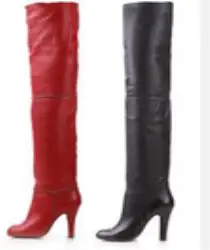
|
During the course of a day wearing this type of boot, particularly if this style is worn regularly, the feet are consistently in a dark and usually moist environment from perspiration. This is a perfect medium for foot fungus to grow, both on the skin and in the nails.
Additionally, there is an inherent set of potential problems in this shoe style not seen in other styles. If the top of the boot happens to be too tight there is an increased chance of nerve damage to the nerves that pass through the knee to the top of the lower leg. The pressure could either be to the back of the knee or the outside of the knee as that is where the two major nerves pass. Excessive pressure from the boot will put pressure on the nerves and can cause sensory problems such as tingling, burning, numbness or outright pain. In a much worse case scenario these types of boots and the excess pressure may also cause motor damage to the nerves innervating the lower leg and foot.
Since the vessels that also bring blood down to the foot and then back up happen to lie near the nerves, there can also be circulatory damage if the thigh boot is too tight. I would be concerned about the inability of the blood to properly drain from the foot and lower leg resulting in sluggish blood flow which could lead to swelling in the foot and ankle. Although I have never actually seen it, I suppose the argument could be made that in those individuals prone to it, a phlebitis could also potentially occur.
sheepskin boots
This type of boot ranging from the brand name version to the knock off versions offer some of the same problems found in thigh high boots and flip flops, yes, flip flops.
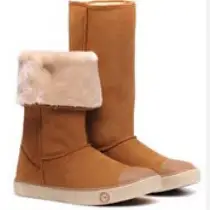
|
Though not quite as bad as flip flops, the sheepskin boot also fails to adequately support the arch. Without adequate support coupled with wearing them on a daily basis in cold weather, the potential for developing plantar fasciitis along with heel spurs is greatly increased. It is worth noting that in most instances where there is plantar fasciitis there is also a secondary problem such as a heel neuroma, heel bursitis and even tarsal tunnel. Forefoot conditions such as metatarsalgia, capsulitis and sesamoiditis can also occur, especially in brands that offer a very flexible sole. All of these problems can become chronic conditions even when the sheepskin boot is no longer worn.
Like the thigh high boots, the sheepskin boots also increase perspiration in the foot as well as an increased darkness due to the height of the boot. So once again the chance of skin and nail fungus is increased. Exacerbating this problem is that people tend to wear these boots almost on a daily basis in almost all seasons with the exception of summer. When the weather is more mild and the boots are being worn on a regular basis, this will increase the likelihood of a worsening effect.
ballet shoes
Ballet shoes have become a very fashionable shoe and so many women wear them on a regular basis. The shoe would have better served mankind has it remained the shoe of choice for ballerinas.
Once again the problem with this shoe is due to the flimsiness of the sole of this shoe. Because the sole is extremely flexible and because there is absolutely no arch support this shoe is an "accident waiting to happen" for many people.
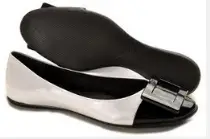
|
Similar to flip flops, ballet shoes do not control the function of the foot and for many, foot control in a shoe is needed for those who have foot type that is either too flat or rigid.
Like the other shoes described in this article, ballerina shoes increase the potential for plantar fasciitis, capsulitis, metatarsalgia and sesamoiditis.
The takeaway message here is if you develop foot pain that you have no explanation for, I would suggest you look to the shoes that you wear on a regular basis as a potential source of the problem. Taking this one step further, if you are under the care of a doctor for a condition and in spite of trying multiple treatments, your foot is not responding, once again, look at the shoes you are wearing. Let's face it, if you are receiving the best medical treatment known to mankind for your particular problem, but are still wearing shoes that aggravate your type of problem, the chances of you getting better are extremely slim.
For those of you who just cannot give up wearing the shoes that you love, even though they may be the source of your foot problem, once small piece of advice would be to cut back on how often you wear these shoes. Alternating shoes is not a bad idea.
REFERENCES


Recent Articles
-
Vitamin D impact on health
Feb 06, 23 07:17 PM
Researchers are suggesting that the effectiveness of Vitamin D in fighting and preventing disease is predicated on a persons body mass index (BMI). The thinner the person the greater the positive impa… -
Foods to speed up healing
Feb 01, 23 02:41 PM
One of the best ways to help yourself heal faster after surgery is to eat well. Getting the proper nutrition will provide your body with the essentials it needs to promote healing. Here is a suggestio… -
Cancer and Type 2 Diabetes
Jan 25, 23 04:52 PM
An article revealing that older type 2 diabetics have a higher incidence of cancer then non-diabetics. It is suggested that cancer may surpass CVD as the number one cause of death in older diabetics. -
Does glucosamine or MSM reduce arthritis pain?
Jan 22, 23 01:41 PM
A good review of the possible benefits to taking glucosamine, chondroitin or MSM for arthritis. Always beware of the possible side effects of over the counter supplements. -
shin splints
Jan 18, 23 05:12 PM
A great review on the various causes of shin splints, along with treatment options. -
Whats new in skin cancer?
Jan 15, 23 08:32 PM
A presentation of newer skin protection combinations in an effort to better protect the skin from the hazards of sun exposure. -
Causes and risk factors of warts
Jan 14, 23 05:02 PM
A good review of the causes of warts and protective measures you can take to prevent developing them. -
Do chronic wounds need to be dressed daily?
Jan 11, 23 02:18 PM
Because of supply chain shortages as well as staffing shortages particularly during the pandemic, many institutions extended the time between dressing changes for chronic wounds. Is this really the be… -
Food choices that raise your risk of type 2 diabetes
Jan 08, 23 10:07 AM
A good review of how blood sugars can become elevated and the harm that can do. Certain food groups have a tendency to raise your blood sugars and should be avoided. -
Outcome stats from Scarf bunionectomy
Jan 03, 23 03:04 PM
The Journal of Foot and Ankle Surgery recently reported a meta analysis of outcomes in 1583 Scarf bunionectomies that met their inclusion criteria. Adverse events did not seem to be any better or wors…